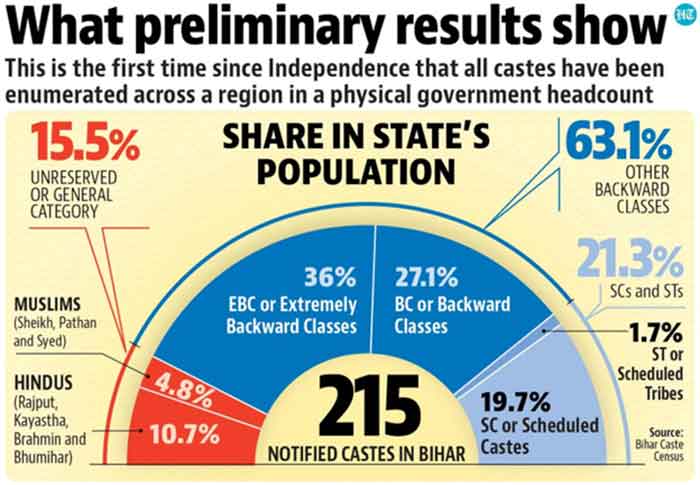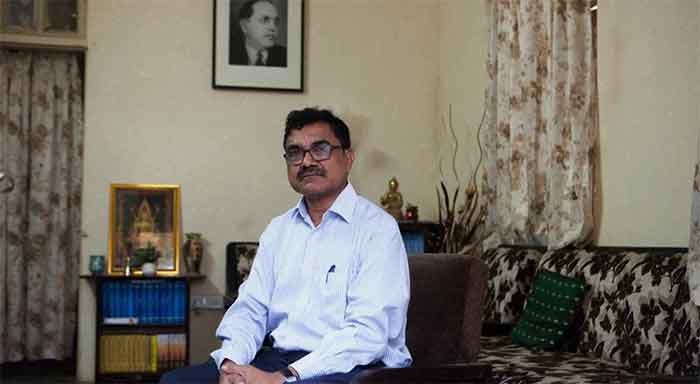Breaking the Myth of Caste
The nation is still debating on Women Reservation Bill which has turned into an act now, and inclusion of OBC women into it then the Bihar state released its data and showed to the country that OBC communities are largest in the state and if they will not get their share then it’s difficult to win the election and at the same time their precarious representation in administration, academic and jobs also come to the fora. On 2nd October, on the occasion of Gandhi Jayanti, Bihar government has released its caste survey data held this year. The data showed expected results as stated by many scholars working on the field especially in terms of numbers of OBCs that they constitute 63.1% of total population. The caste census has given a new path for social justice where justice will be given on the basis of a suitable number. The data had also re-advocated the demand of ‘Jiski jitni sankhya bhari, uski utni hissedari.’
Background
The first census was carried out in the British period in the year 1872 but the systematic census carried out in 1881, since then, the census had been carried out uninterruptedly. When it comes to the caste census, the last data we have is from the census of 1931, while data on caste was gathered in 1941 but not published in the public domain.
In Independent India, caste was not included in the census because it was believed the British collected information for the purpose of dominance, hence such classification was unnecessary. Since, 1931 this is the first official data on caste, however, the process was not smooth for Bihar. It was challenged in high court, but the Patna high court ruled that the state’s objective was legally correct, and the census was conducted for development and equitable treatment, hence therefore entirely acceptable.
Key Takeaways
According to the Caste Survey Report, 15.5% of the population belongs to the so-called advanced caste. Thus, it invalidated the widespread belief among the masses that the advanced castes are numerically dominant. In terms of Other Backward Castes, the state provided separate statistics for Backward Castes (27.1% of total population) and Extremely Backward Castes (36% of total population). On the other hand, the Scheduled Castes and Scheduled Tribes account for more than 20% of the state’s population.

Source-Hindustan Times
Impacts
There was much debate about the need for a caste census following the EWS reservation to the advanced castes. According to some of the rhetoric, caste has disappeared from Indian society; caste is a rural problem that has vanished from cities. Multiple research and media reports regarding residential segregation and urban caste hierarchies have already dispelled these myths. Several studies and news reports have previously disproved the claims about residential segregation and urban caste systems and pointed out on the usage of discriminatory practises while renting out a home.
It also dispelled the largest fallacy, which was that we, the so-called “quota students,” have been admitted to the best institutions like IITs, IIMs, AIIMS, JNU and DU because of the reservation we received. The erroneous assumption was primarily founded on forward caste rhetoric about their vast numbers. Following the caste study, it became clear that these opinions were only present to prevent deserving candidates as it perpetuates their caste domination in the society.
The EBC Factor
The data shows that EBCs (Extremely Backward Castes) are largest in numbers in Bihar, but their representation is very low in the states, in the name of OBC representation most of the seats had been acquired by dominant OBCs like Yadavas, Kurmis of Bihar, the data will intensify EBCs to come under the single umbrella of EBCs to ensure their representation in every arena.
In the whole nation, there is constant demand of the sub-categorisation of OBCs the data will strengthen this demand and there are high chance, that the EBCs will be given a new category which will create a new identity for themselves where their issues will be different from OBC community.
The statistics will visualize Karpoori Thakur’s goal of emphasizing the significance of Extremely Backward Castes in society, and there will be an increase in the proportionate demands. The result has also promoted other states like Telangana, Karnataka, Odisha to release their data of caste survey and this is not going to stop because other states will also demand for the caste census which will ultimately promote proportional representation.
Overall, it can be ground-breaking for OBC communities, Today, we see that OBC communities are largest in numbers, but their representation is very minute in academics, judiciary, bureaucracy, the data will boost their morale and they will become more aware about their rights. The data will extend support to the demands of crossing of reservation ceiling capped by the Supreme Court. There is constant demand by opposition leaders, social activist, academicians that there should be caste census in India. The Bihar data can become trigger point for whole nation where every state will ask for such data and that will lead change in policies by the government because marginalized needs more justice.
Ritu has completed her Masters from JNU and MPhil from Delhi
University. Her interests are largely based on the caste politics and socio-political anthropology, women question and low caste representations.













































